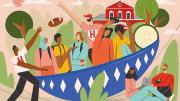On one of the earliest days of my freshman fall, I left Harvard Yard with a backpack full of years-old merchandise and more confusion than I had ever asked for. I had just survived the annual student activities fair, which had been swarmed by first-years eager to fashion themselves anew through extracurricular commitments. The largest section of the fair was a triangle of grass dotted with booths all dedicated to so-called affinity organizations.
Within a few months, I joined one of them: South Asian Americans in Public Service, an organization I joke to my friends is the most niche one they’ll find at this school—aside from, maybe, the Harvard College Half Asian People’s Association. I had stumbled onto it, the same way some of the most meaningful experiences are not sought out but serendipitous.
First-years navigate this web of cultural organizations as they begin their Harvard journey. I recall puzzling through the options my own freshman fall, having slowly joined the orbit of the South Asian Association, Ghungroo, the Bhangra team, and SAAPS. I felt utterly overwhelmed. My identity was now a matter of choice: yes, I was born into an Indian American lineage, but would I let that govern my social interactions? Would I display that identity through dance, through art, through conversation? I also felt a slight worry that affiliation by identity was a reductionist approach to human relationships. Most people engaging in affinity organizations have at some point asked themselves: is what connects us only skin-deep?
These questions are part of a larger dilemma of what a multicultural campus—and for that matter, a multicultural society—should look like. Cultural diffusion could whisk away these different identity markers, turning affinity organizations into vestigial organs of our student body. Or we could attempt to retain as much of our personal cultures as possible, and attach significance to identity-based similarities. These two competing visions play out on the arena of Harvard’s campus.
The College boasts 105 racial and cultural organizations, and SAAPS is one of many which cater to students of South Asian heritage. The organizations themselves echo larger structures of political and social identity: the Asian American Association serves as a continental umbrella, with regional groups such as the South Asian Association carving out distinct sub-identities. Even smaller units follow from those, such as the Nepali Students Association, the Taiwanese Cultural Association, and the Bangladeshi Students Association. Running alongside these nationality-based organizations are artistic and religious groups whose membership spills beyond political borders, such as the Harvard Islamic Society.
While many of the smaller groups have struggled to achieve a prominent profile, larger groups often grapple with a degree of cultural erasure. For instance, the Asian American Association largely leaves out South Asians, a fact that a handful of South Asian freshmen discover each year as they attend an introductory event serving boba tea (originally a Taiwanese treat), only to find themselves the sole brown faces present. The phenomenon mirrors the American lexicon of identity, which takes Asian Americans to refer mainly to East Asians, ignoring a swath of countries whose inhabitants never popularly qualify as the “real Asians.”
Even more specific regional groups are not without their blind spots, either, even as student leaders consciously work to make their organizations more inclusive. The South Asian Association has traditionally often focused on India, and more specifically, north India—pushing some students away and toward smaller organizations that celebrate regional and national differences within the subcontinent. This north-Indian focus shows up in small details at association events, like the omnipresence of samosas at the expense of any other regional food, and in larger questions at the heart of those get-togethers: the hyperfocus on Indian traditions, the overemphasis on Hindi above all other languages, and the subtle social dynamics which privilege Indian American cultural identities. Ghungroo, our annual student-run South Asian cultural production of music, dance, spoken word, and other arts, has sometimes been called a “Bollywood show”—one which ignores the more than 25 other movie industries and countless other art forms in South Asia.
Still, cultural groups serve as anchors of community, and I was drawn to their steady pull. Affinity organizations seemed to present a social safety net, guaranteeing a community of friends when no others beckoned. It wasn’t hard to see the appeal. During my first year, I hopped from one friend group to another, never quite feeling fully at home. But in the cultural organizations, I was quickly enveloped in the comforts of ethnic kinship: jokes understood, experiences shared. A white friend of mine bemoaned the lack of a similar group—apart from final clubs.
Many children of immigrants fall into this social safety net once they enter college, clustering among those who share their identity. As sociologist Peggy Levitt writes, college presents an opportunity for young people to define their identity on their own for the first time and to find a community of people with similar experiences.
While affinity spaces are often construed as “safe,” they can also be exclusionary. Over the years, I’ve chatted with classmates who say these groups can sometimes feel like a closed door, reproducing the stratifications of class, gender, and other axes that alienate students straddling multiple identities. A low-income friend once mentioned how ethnicity-based organizations can feel like exclusive cohorts of upper-class students. A Latin American student spoke about questions of gender: “We’ve had conversations about whether the Latino Men’s Collective should even exist.” In the South Asian community, we’ve had similar conversations.
The concern is not unique to student cultural groups—it has dogged identity-based activism for years. People at the margins have criticized LGBTQ+ coalitions for excluding the working class, the civil rights movement for excluding women, and feminist organizations for excluding black women.
Still, there’s something about affinity groups that seems to provide some protection, or at least comfort, in a world marked by racial estrangement. Bernice Johnson Reagon, a black feminist scholar of the 1970s, described these spaces as “rooms,” small homes of kinship. Reagon participated in the Freedom Summer campaign in 1964 to register black voters in Mississippi and in the wave of feminist organizing that followed a decade later. In this context, her “rooms” served quite literally as “safe spaces,” protecting women and African Americans from the violence that they faced on the streets. Still, she wrote, such rooms were also confining, out of touch with the multiracial reality beyond their doors: “It’s nurturing, but it’s also nationalism.” Genuine change, Reagon wrote, means abandoning these confinements: “Coalition work is not work done in your home. Coalition work has to be done in the streets. And it is some of the most dangerous work you can do.”
College presents a parallel situation, forcing us to escape our rooms as we join a student body of vastly different backgrounds. That is especially the case at Harvard, where the admissions policy, now under Supreme Court review, attempts to foster racial and ethnic diversity. Attorneys have argued that this admissions policy preserves a diverse learning environment essential for developing attentive students entering a multiracial society. But how much can we learn from each other if we still silo ourselves in our own rooms? I and many of my fellow students in cultural organizations question whether we are contributing to our own segregation. At the start of my freshman year, a friend’s Instagram caption bemoaned, “If Harvard’s so diverse, why am I only spending time with other Chinese Americans?”
And yet, integration often comes with difficult sacrifices. The loss manifests in sometimes small but meaningful ways: a shakier accent, declining familiarity with music and culture, a growing distance from the affairs of a home country. My friends and I often admit, with some guilt, that our language skills have atrophied significantly over the years. To a certain extent, this process is inevitable for immigrants living far from their homelands. But it feels as though our everyday decisions—what to listen to, how to speak with our parents, and yes, whom to befriend—somehow contribute to the geography of emotional distance from our origins.
These slow, individual changes align with broader theories about how people adapt to the dominant society. In the past, scholars have heralded the “beiging of America” as an ideal to strive toward. But I can’t help but feel that in practice, the shade of beige we arrive at will always be more white than brown. That’s the unidirectional vision of assimilation put forward by the “melting pot” theory. What we have at Harvard, on the other hand, is closer to a salad bowl: distinct personalities, all tossed together—not blending, but cohabiting.
Perhaps it is not wholly impossible, though, to reconcile the pull toward ethnic community with a broader appreciation for different lived experiences and a genuine effort toward cross-cultural solidarity. During this past fall semester, I attended a Diwali celebration hosted by the Hindu student group Harvard Dharma and Mather House faculty deans L. and Amala Mahadevan. The Mahadevans had generously lent their residence for the festivities. Diyas blanketed the room in a soft glow; a chalk rangoli inhabited the corner; and small, intricately designed rugs covered the entire floor. Seniors had arrived at the residence at 9 a.m., meticulously arranging deities, laying out the carpets, and bustling through the kitchen to assemble a home-cooked dinner for around 120 people. As the processions began, seniors read bhajans from pamphlets as they performed a ritual traditionally undertaken by adults; it was a rite of passage, though only those familiar would read it as such.
The sense of belonging and fulfillment was stronger than I had felt since returning to campus after the pandemic’s remote year. I was also reminded that it isn’t impossible to knit together a vision of cultural celebration with one of cross-cultural diffusion. The Diwali festivities attracted friends I knew from all backgrounds, South Asian and non-South Asian. It seemed we did have before us a salad bowl, but one where we could learn from each other’s unique cultures while celebrating our own.









